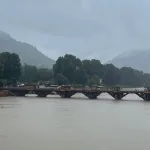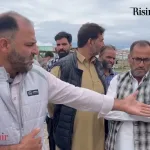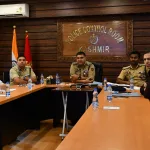Nature has truly blessed Uri with some of the most breathtaking scenic treasures in Kashmir. Located between majestic mountains and lovingly touched by the flowing Jhelum River, this warm and welcoming region is a hidden gem waiting to be discovered. Far from the hustle of commercial tourist circuits, Uri offers a serene escape where lush green valleys, whispering pine forests, and age-old shrines blend seamlessly with the timeless charm of nature.
Every corner of this region tells a story—untouched, unspoiled, and deeply rooted in cultural and ecological richness. In the serene upper reaches of Garkote village in the scenic tehsil of Uri, District Baramulla, lies a place that touches both the soul and the imagination—Baba Farid, a spiritual site so pure, so serene, that it feels like time itself pauses in its presence. Recently, I had the privilege of visiting this hidden jewel, untapped gem of natural beauty and cultural richness and what I experienced wasn’t just a journey—it was a rediscovery of identity, culture, community, and the forgotten promise of border tourism.
The journey to this destination is no ordinary one. Unlike the mainstream tourist destinations accessible by highways and dotted with amenities, reaching Baba Farid demands an effort of both body and spirit. With no motorable road available, the only way to access the site is by foot. The trek, however, is not just a physical one—it is a deeply reflective experience. As I ascended the trail lined with dense pines, chirping birds, and the whisper of cold mountain air, each step seemed to peel away the noise of the world below, revealing an untouched realm of purity.
Situated atop the lush green heights of Garkote, the shrine offers panoramic views that could rival any famed hill station. Its calm aura, vast meadows, and cool breeze make it an ideal place for ecotourism. But beyond the natural charm, it holds within its silence a call for attention—a call for recognition as a destination that could significantly reshape the economic and social fabric of Uri through sustainable tourism.
Reaching Baba Farid isn’t easy. There’s no motorable road, no shortcut to convenience. You have to earn your way there. You walk. You climb. You breathe in the scent of wild herbs, you hear the trees whisper secrets from generations past, and with each step, you feel something inside you grow quieter—more aware. The uphill path through dense forests and gentle meadows becomes a kind of spiritual purification.
As I reached the sacred site, the fatigue faded. The shrine of Baba Farid stands surrounded by vast meadows and beautiful tall pine and cedar trees. A soft breeze carried with it the silence of centuries, and the peace that hung in the air was something words often fail to capture. It was more than just a religious site—it was a sanctuary of stories, of forgotten dreams, and of unrealised potential.
What struck me immediately was not just the physical beauty of the place, but its raw potential as a powerful tourist destination. With the right vision and infrastructure, this location could evolve into a nucleus of eco-tourism, border tourism, and adventure activities. The wide open meadows, the elevated cliffs, and the sheer expanse of sky above make it a dream spot for paragliding.
A future-forward proposal includes the idea of a cable car system to connect Garkote to Baba Farid. This initiative could open the area to visitors of all ages and abilities, encouraging a more inclusive form of tourism. Complemented by well-managed eco-camping zones, this development could turn Baba Farid into a prime destination for nature lovers, seekers of peace, and thrill-seekers alike.
Scattered across the gentle slopes leading to Baba Farid are small, rustic dwellings known locally as “Kothas”—simple yet soulful houses made from mud, stone, and timber, crafted lovingly by the hands of local herders and farmers. These seasonal homes come alive between April and September, when families from nearby villages shift here with their cattle and livestock to graze in the lush alpine pastures. Life in the Kothas is humble but deeply connected to nature.
Smoke rises from small hearths, children chase after lambs, and the earthy aroma of locally grown vegetables like beans, potatoes and wild herbs fills the air. The sight of these quaint huts sitting quietly along the slopes, surrounded by rolling meadows and pine-covered hills, brings a special charm to the entire area—reminding every visitor that this place isn’t just beautiful, it’s alive, rooted, and full of tradition. These Kothas are more than just shelters—they are living expressions of the age old bond between people and the land, adding warmth and meaning to the natural surroundings of Baba Farid.
During my time there, I had the opportunity to meet a warm and lively group of people from Garkote and the adjoining villages who had also chosen this location for a spiritual and recreational retreat. They had camped at the site for two nights, something that is not very common in this part of Kashmir, and yet so fulfilling. Sitting under the shadow of pine trees we shared stories of our land, our aspirations, and our shared longing to see Uri and its hidden gems shine on the tourism map of Jammu and Kashmir.
We also had heartfelt interactions with the local people living in the nearby Kothas. Sitting under the open sky, under the shadow of pine trees they shared their simple yet powerful stories—of seasonal migration, cattle grazing, traditional farming, and life lived close to nature. Despite the hardships of living in remote highlands, their warmth, hospitality, and deep love for their land shone through every word. Many of them expressed a strong desire to see their homeland flourish and welcomed tourists with open arms, urging more people to come, experience the beauty, and understand the quiet strength of these hills. Their voices carried a hopeful message—that tourism rooted in respect and care can help preserve their way of life while opening new doors for the region.
One of the most enriching parts of my visit was an engaging and detailed conversation with Mr Maqsood Khawaja of Garkote, a well-known media personality from the region—a prominent broadcaster and Editor-in-Chief of the famous radio program Shehrbeen and Incharge of the Pahari segment on All India Radio Srinagar. As we sat under a small chinar tree, we spoke at length about the potential of border tourism in Uri. The dialogue wasn’t just casual; it was layered with insight, passion, and an in-depth understanding of the region’s unique cultural and geographical identity. He emphasized how areas like Baba Farid, which hold immense historical, spiritual, and ecological value, could become a focal point for tourism if supported by infrastructural development and conscious policy planning.
The conversation pivoted around how border tourism could not only offer visitors a chance to experience life of people residing in these places but also narrate stories of resilience, tradition, and natural beauty that remain largely unknown to the rest of the world. He also shared his own experience and efforts in making this place a famous tourist destination. We both shared concerns over the region being constantly viewed only through the lens of conflict, while ignoring its vast potential for harmony-driven tourism that connects people to their roots, nature, and shared history.
The natural topography of Baba Farid lends itself effortlessly to adventure-based tourism. With its sloping meadows and steep cliffs, the area is ideal for outdoor activities like trekking, and paragliding. If developed responsibly with proper safety protocols and trained staff, these adventure sports could attract a new wave of tourists seeking thrilling yet immersive experiences. Our dialogue, deeply engaging and rooted in our shared bond with Uri, explored ideas of conscious tourism, cultural revival, and the need for meaningful infrastructure. Maqsood Sahab’s experiences and stories offered an invaluable perspective. His voice underscored the belief that Uri is not just a border town—it’s a place of soulful significance with untapped opportunities for peace-driven tourism and regional upliftment.
Baba Farid, we both agreed, could be a flagship of border tourism—offering not just scenic views, but immersive experiences into life. It’s not about making Uri a commercial carnival— it’s about creating responsible tourism that respects local culture, sustains ecology, and uplifts community livelihoods.
Access to Baba Farid has long remained a challenge, with visitors currently having to trek on foot through steep and forested trails to reach the site. While a road has been constructed up to Upper Latymar in Garkote, offering hope for easier connectivity, the work beyond that point has unfortunately come to a halt due to certain administrative and logistical hurdles. This incomplete stretch continues to limit access, especially for the elderly, differently-abled, and potential tourists. For a site with such immense spiritual, ecological, and tourism value, it is essential that the road construction is resumed and completed at the earliest. Enabling vehicular movement to Baba Farid would not only ease the journey for locals and pilgrims but also pave the way for sustainable tourism, economic growth, and greater visibility of this hidden gem.
The MLA (Dr Sajjad Shafi) of Uri has recently launched the ambitious “Uri Chalo” Vision, a forward-thinking initiative aimed at unlocking the region’s immense potential for border tourism, ecotourism, culture & heritage tourism and pilgrimage tourism. Rooted in the belief that Uri is not just a strategic frontier but also a reservoir of natural beauty, spiritual heritage, and cultural richness, the vision seeks to put places like Baba Farid, Qazinag Kamalkote, NHPC Reservoir Sites, Kaman Aman Setu, Gurudwara Chhatti Padshahi, Paranpillan, Pandav Temples, Waterfall Nambla, Limber & Lachipora Wildlife Sanctuary, Babagail Bonyar, Baaz, Bosiyan and other hilltop locations on the tourism map.
By focusing on sustainable development, the “Uri Chalo Vision” emphasizes eco-friendly infrastructure, community-based tourism, and youth engagement, with plans for nature trails, view points, adventure activities, and home stay networks. The “Uri Chalo Vision” carries a hope—to bring jobs to youth, dignity to local traditions, and a new identity to Uri as a place for potential tourist activities. It is due to these efforts locations like Waterfall Nambla, Kaman Aman Setu have been listed as the tourist sites by the concerned Department and other locations are also in this queue.
Economically, this shift could bring transformative change. Local youth can be trained as tourist guides, paragliding instructors, hospitality service providers, and conservation workers. Women in nearby villages can run home stays, prepare and sell traditional cuisine, and make handicrafts for tourists. The ripple effect would touch almost every sector—from agriculture and transport to education and healthcare—breathing new life into Uri’s economy which otherwise remains subdued due to its geographical sensitivity and limited opportunities.
Yet, the most pressing need is to develop the area without disturbing its essence. The tranquillity of Baba Farid is its soul. Any tourism model must be designed around minimal environmental impact. The spiritual purity and natural rawness of the place should not be sacrificed at the altar of development. It is entirely possible to grow without destroying.
One day, perhaps soon, paragliders will glide over these sacred slopes, cable cars will ferry pilgrims and adventurers alike, and campfires will light up meadows where stories are shared under stars. And when that day comes, it won’t just be Baba Farid rising into the spotlight—it will be Uri, in all its forgotten beauty, finally finding its voice.
(Author is a Nursing Research Scholar from Nambla Uri)








